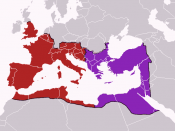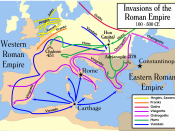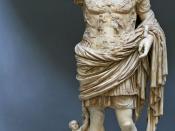Historically the date given for the beginning of the Roman Empire is 27 BC when the Roman Senate gave Gaius Octavius the name Augustus and he became the undisputed emperor. At its peak, the empire included lands throughout the Mediterranean world. Rome had first expanded into other parts of Italy and neighboring territories during the Roman Republic, but made wider conquests and solidified political control of these lands during the empire. The Roman Empire encompassed a huge amount of territory, but also allowed people of many different cultures to retain their heritage. The empire helped to perpetuate the art, literature, and philosophy of the Greeks, the religious and ethical system of the Jews, the new religion of the Christians, Babylonian astronomy and astrology, and cultural elements from Persia, Egypt, and other eastern civilizations. The Romans provided their own peculiar style of government, law, and architecture and spread their Latin language.
In this way, the Romans and their empire created a Greco-Roman cultural and political shape that would influence the subsequent history of Europe from the Middle Ages and the Renaissance to the present day.
Why Was the Roman Empire Successful?At the very heart of the Roman Empires, success was the government's ability to create and maintain systems of communication, trade, and travel. For centuries, Rome was able to maintain a stable currency and a prosperous international trade. This was possible because of the infrastructure built by the soldiers during times of peace. The roads were primarily built to provide rapid movement of the military but were exploited by merchants plying their trades. This extensive road network allowed Rome to import and export goods from anywhere in the Empire as well as from China, India, and other outlying areas.
Credit for the success of the Roman Empire is certainly given to...


